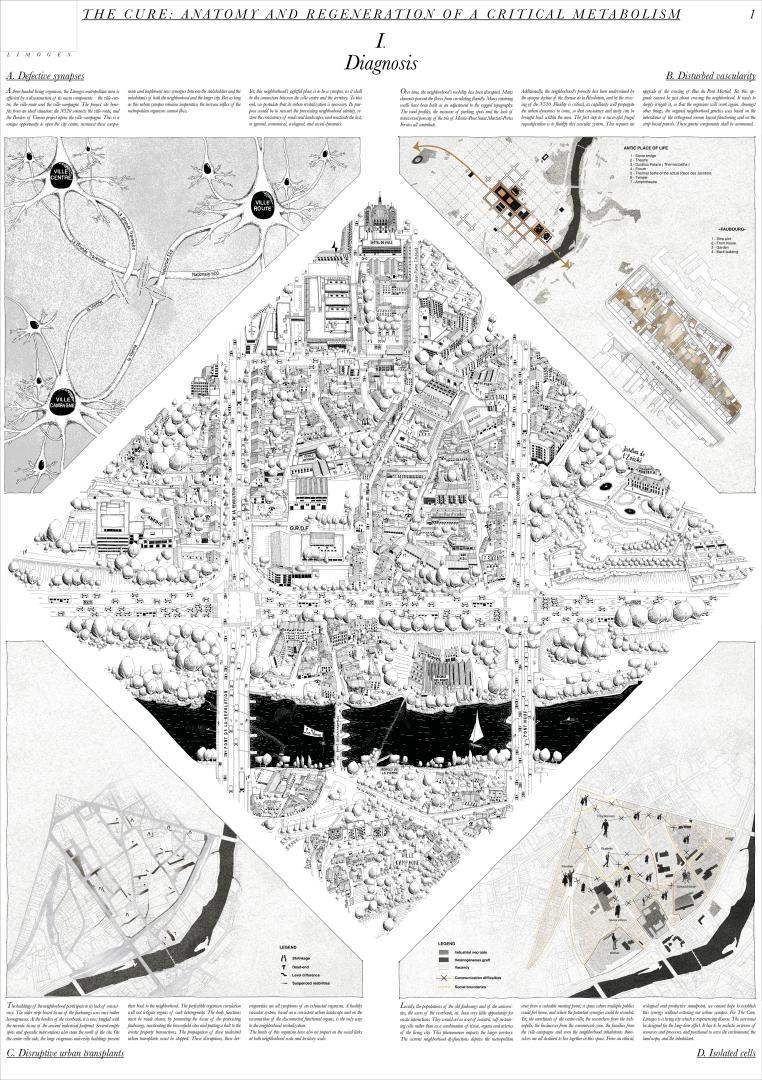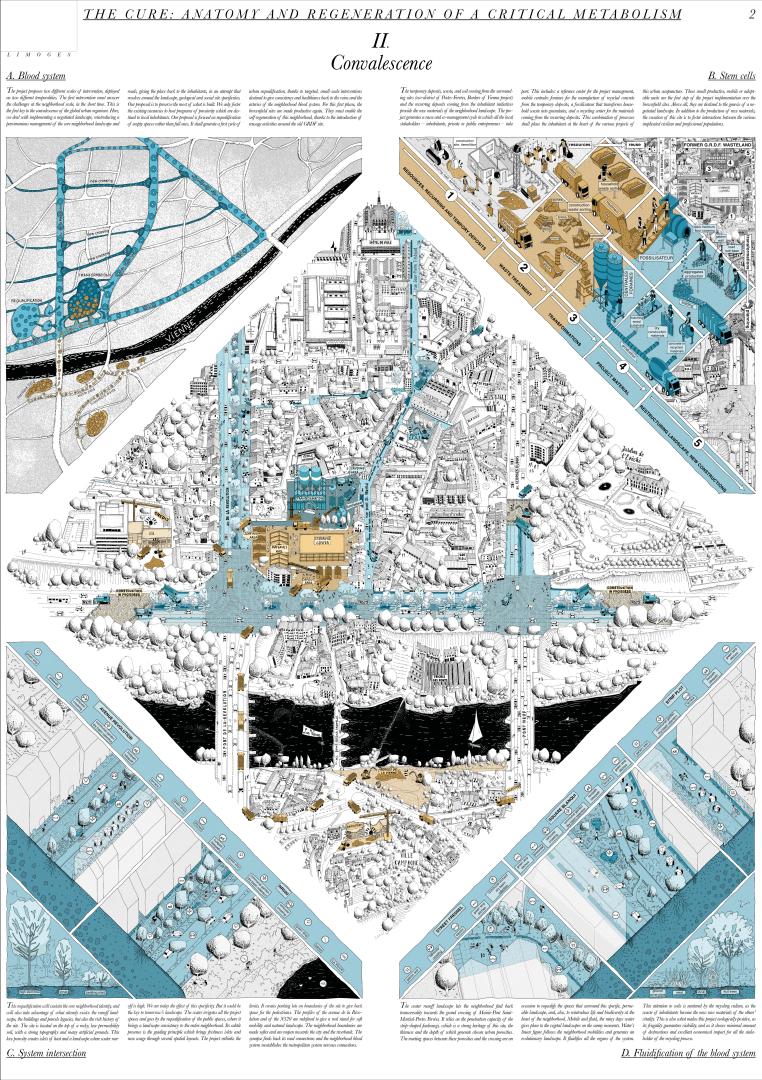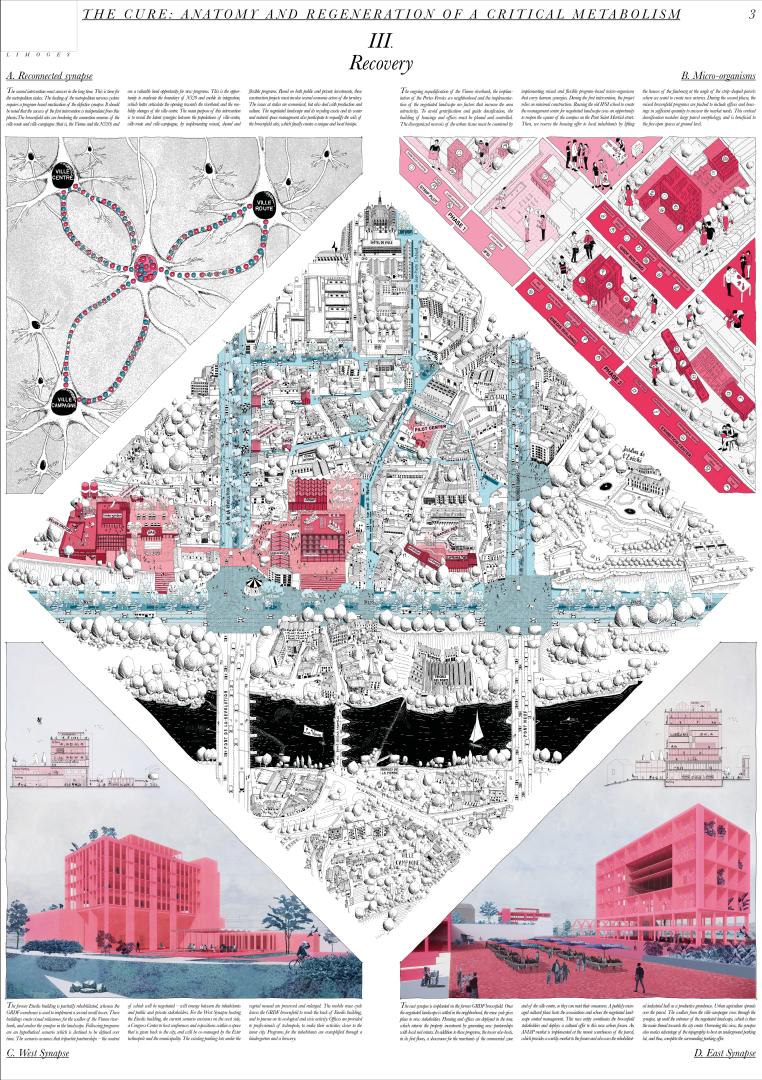The Cure
Basic information
Project Title
Full project title
Category
Project Description
Our approach is characterised by a simple principle: the city is self-sufficient for her own regeneration. We considerate the territorial limougeaud field, as an urban mine whose untapped resources are sufficient to generate a new urbanity, thanks to the process of reuse, focused on landscape, bonds between inhabitants and stakeholders’ synergies. The living, whether it is human, animal, or vegetal, has been reintroduced as a suture element intended to merge urban practices in a consistent whole
Geographical Scope
Project Region
Urban or rural issues
Physical or other transformations
EU Programme or fund
Which funds
Description of the project
Summary
Our concept corresponds to the formulation of a guide plan for the Saint-Martial district in Limoges. Following the concept of “Living city”, we proposed a conceptual approach of the city of Limoges as a metabolic urban organism. As a three-headed living organism, the Limoges metropolitan area is affected by a disconnection of its main components – the ville-centre, the ville-route and the ville-campagne. The project site benefits from an ideal situation and consitutes a unique opportunity to open the city centre, reconnect these components and implement new synergies between the stakeholders and the inhabitants of both the neighborhood and the larger city. In this vision, the project site constitutes a urban synapse. As long as this urban synapse remains inoperative, the nervous influx of the metropolitan organism cannot flow.
The project is characterized by a simple principle: the city is self-sufficient for its own regeneration. It proposes to considerate this object, the territorial limougeaud field, as an urban mine whose lost or untapped resources are sufficient to generate a new urbanity, thanks to the process of reuse. This new urbanity is focused on a local landscape - built from urban mine resources - bonds between inhabitants and stakeholders’ synergies.
The process includes simultaneously natural, human and economic aspect of such operation. The project generates a reuse and co-management cycle, in which all the local stakeholders can take part. The objective is to oversee the district evolution in order to develop new dynamics, reintroduce living and water into the urban fabric and protect local citizens from agressive gentrification and housing market abuse. Moreover, it gives the opportunity to engage and spread industrial ecology processes.
The reactivation of the synapse is based on a phased cure built from an human, biological and carring approach of urban thinking.
Key objectives for sustainability
The site is located on the top of a rocky, low permeability soil, with a strong topography and many artificial grounds. This low porosity creates islets of heat and a landscape where water runoff is high. We are today the effect of this specificity. But it could be the key to tomorrow’s landscape. The water irrigates all the project spaces and goes by the requalification of the public spaces, where it brings a landscape consistency to the entire neighborhood. Its subtle presence is the guiding principle which brings freshness islets and new usage through several spatial layouts.
The soils’ requalification of the district and of its limits is in the heart of this process. Minerality, absence of groundwater and site topography lead to the creation of a landscape characterized by runoff water absorption. Disseminated across the district, this landscape harmonizes its identity.
The temporary deposits, waste, and soil coming from others construction sites and industrial fabrics and the recurring deposits coming from the inhabitant initiatives provide the raw materials of the neighborhood landscape. This includes: a reference center for the project management, mobile centrales foraines for the manufacture of recycled concrete from the temporary deposits, a fossilisateur that transforms household waste into granulates, and a recycling center for the materials coming from the recurring deposits. We identify local supplies chains to define specific reused finished products in order to draw local public spaces from local revealed resources.
Introduce living and water into the city is a way to restore ecological corridors. Connected to the hydrographic figure of the Vienne river, it reconnects the city to the territorial landscape. Ecological bonds are renewed.
This territorial governance approach, based on a biocompatible urbanity adapted to local specifities and social links, is a concept highly reproducible.
Key objectives for aesthetics and quality
The issue was to give back common places for the Limougeauds to stroll, to play, to find a shared friendliness around a set of landscape sequences intended for wandering. The combination of processes related to the reuse cycle shall place the inhabitant at the heart of the various projects of this urban acupuncture. It is this very requalification will sustain the core neighborhood identity, and will also take advantage of what already exists: the runoff landscape, the diversity of what has been built and of the parcels, but also the rich history of the site, would it be in terms of road and buildings roman heritance, of industrial buildings or of the faubourgs tissue.
The project rethinks the limits. It creates parking lots outside of the site to give back space for the pedestrians. The profiles of the avenues are redefined to give a real stand for soft mobility and natural landscape. The neighborhood boundaries are made softer and are reopen towards the city and the riverbank. The synapse finds back its road connections and the neighborhood blood system reestablishes the metropolitan system nervous connections.
Mobile and fluid, the rainy days water gives place to the vegetal landscapes on the sunny moments. Water’s linear figure follows the neighborhood mobilities and generates a landscape that evolves along the seasons. It fluidifies all the organs of the system and upgrades the spaces that had been left aside. This attention to soils is nurtured by the recycling culture, as the waste of inhabitants become the new raw materials of the others’ vitality. This is also what makes this project ecologically positive, as its frugality guarantees viability, and as it shows minimal amount of destructions and excellent economical impact for all the stakeholder of the recycling process.
This approach includes a playful and shared public places appropriation, around natural figures. It is a ecological respectful urbanity created for the citizens, by the citizens.
Key objectives for inclusion
The project proposes two different scales of intervention, deployed on two different temporalities.
The first intervention must answer the challenges at the neighborhood scale, in the short time. This is the first key to the convalescence of the global urban organism. Here, we deal with implementing the negotiated landscape, reintroducing a parsimonious management of the core neighborhood landscape and roads, giving the place back to the inhabitants, in an attempt that revolves around the geological and social site specificities. Our proposal is to preserve the most of what is built. We only foster the existing vacancies to host programs of proximity which are destined to local inhabitants. Our proposal is focused on requalification of empty spaces rather than full ones. It shall generate a first cycle of urban requalification, thanks to targeted, small-scale interventions destined to give consistency and healthiness back to the veins and arteries of the neighborhood blood system. For this first phase, the brownfield sites are made productive again. They must enable the self-regeneration of this neighborhood, thanks to the introduction of reusage activities. Beside inhabitant’s bond, the public space requalification provides an existing land revaluation and, therefore, begins a set of refurbishments on private stakeholders’ initiatives. Participative, this set of regulated refurbishment is implement to preserve current population from agressive gentrification.
Once the reuse cycle is achieved, a second life will be offered to the wastelands, based on a set of public-private partnerships that generates a reuse and co-management cycle in which all the local stakeholders – inhabitants, private or public entrepreneurs – from the three different territorial areas are involved to implement mixed, shared and flexible programs. The vocation of this site is to foster latent synergies between the various implicated civilian and professional populations.
Physical or other transformations
Innovative character
The limits of this organism have an impact on the social links at both neighborhood scale and territory scale. Locally, the populations of the old faubourgs and of the universities, the users of the riverbank, etc. have very little opportunity for onsite interactions. They would act as a set of isolated, self-sustaining cells rather than as a combination of tissue, organs and arteries of the living city. This phenomenon impacts the larger territory. The current neighborhood dysfunctions deprive the metropolitan area from a valuable meeting point; a space where multiple publics could feel home, and where the potential synergies could be revealed. Yet, the merchants of the centre-ville, the researchers from the technopôle, the businesses from the commercial zone, the families from the ville-campagne and even the neighborhood inhabitants themselves are all destined to live together in this space. From an ethical, ecological and productive standpoint, we cannot hope to establish this synergy without restoring our urban synapse.
For The Cure, Limoges is a living city which is experiencing disease. The cure must be designed for the long-time effect. It has to be realistic in terms of resources and processes, and positioned to serve the environment, the landscape, and the inhabitant. The shared new programs like the local refurbishments and the negotiated landscape and its recycling assets and its water and natural space management also participate to requalify the site, which finally creates a unique biotope that can’t be found elsewhere. Thus, we propose to reveal local territory assets across common shared values. The issues at stakes are economical, but also deal with production and culture.
Our answer, although specific to the project site, includes in reality a set of processes and cycles which can be reproducible in other places, provided that it has been adapted to realities of each territory, geography and population.



